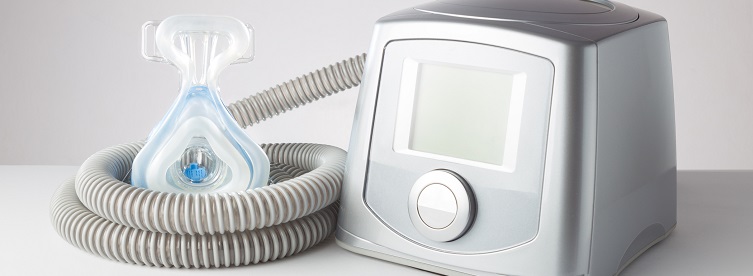Find care now
If you are experiencing a medical emergency, please call 911 or seek care at an emergency room.

An estimated 50 to 70 million Americans suffer from serious chronic or intermittent sleep disorders that undermine the quality of their sleep and, more importantly, their health. Sleep apnea, the most common disturbance, is also potentially the most serious, raising the risk of high blood pressure, arrhythmias, diabetes, heart failure, heart attack and stroke. At its most severe, it can even cause death.
Fortunately, modern medicine can diagnose and treat obstructive sleep apnea before it ever reaches such dangerous stages. Key to our success was the development of the continuous positive airway pressure device known as CPAP. The front-line therapy for nearly 30 years now, CPAP is a safe, non-invasive and highly effective treatment for the disorder, when used as directed. However, compliance can be a problem.
Why?
Some people find the devices noisy and uncomfortable. Those with claustrophobia have problems adjusting to a mask that covers the nose and, with some models, also the mouth. And restless sleepers have trouble keeping them on.
As a result, only between 30 and 60 percent of patients with the devices actually use them regularly and for the prescribed amount of time each night.
So clinicians and researchers have come up with new methods to tackle the problem.
Understanding Obstructive Sleep Apnea
First, it helps to understand the mechanics behind sleep apnea, which is marked by pauses in breathing called apnea episodes, or shallow breathing called hypopnea episodes, during sleep. When you sleep, the throat muscles that normally keep your airway stiff and open relax, narrowing the passageway. That’s normal. However, certain conditions or even the physical structure of your mouth can momentarily prevent enough air from getting to your lungs. A partial blockage produces loud snoring or irregular breathing, while a complete obstruction usually results in a sudden snort or gasp as the oxygen-starved brain startles the body awake.
These breaks in breathing can last from a few seconds to minutes, and have been recorded over 100 times an hour.
Among the causes of sleep apnea are age, sex (with males at a higher risk) and, increasingly, obesity as excess fatty tissue can thicken the wall of the windpipe, narrowing the opening.
Finding the Right Fix
Beyond lifestyle changes and CPAP, specialists have a range of other approaches to treat sleep apnea. Choosing the right therapy depends upon determining the source of the problem and on patient preference. We start with a careful and thorough evaluation, including physical examination, a detailed medical history, an overnight sleep study and an endoscopy to look at the airways and arrive at the correct diagnosis.
For patients with large tonsils or an elongated soft palate, treatment can include removing the tonsils and shortening the palate. Another approach, especially when patients have excess or enlarged tissue at the back of the tongue, is transoral robotic surgery to remove the excess tissue, or radio frequency ablation which shrinks the tongue or soft palate.
In other cases, the very structure of the upper or lower jaw is the culprit. To eliminate the condition, oral surgeons can actually advance the upper and lower jaws to open up the airway. These procedures have a high success rate, sometimes accompanied by an unintended consequence: a better-looking jaw line!
But a newer approach is proving to be even better for some individuals.
Novel Approach Offers Improved Solution
Approximately two years ago, the FDA approved a promising new technology to treat sleep apnea called the hypoglossal nerve stimulator. (Full disclosure: I sat on the final FDA review board.) Basically, the technology acts like a pacemaker, helping to synchronize the intake of air with the action of the tongue. The pacemaker apparatus is implanted in your right chest, and connected to a wire that is wrapped around the nerve that controls tongue movement. A second wire implanted in the side of the right chest senses when you breathe in, causing the pacemaker to signal to the tongue to move forward and out of the way, opening the airway. The device is turned on and off by the patient, so daytime breathing is not affected.
To date, the stimulator has been used in hundreds of patients with very good success. I’ve personally used it on about 15 patients with an 85% success rate. However, not everyone is a candidate for the approach. Patients must have moderate to severe sleep apnea, as indicated by a sleep apnea severity score (Apnea Hypopnea Index or AHI) between 20 and 65, and a body mass index (BMI) less than 32. The latter, in particular, rules out many who could benefit from the procedure. As a result, I often refer my obese patients for consideration of bariatric surgery to help lose weight instead.
But for those who fit the criteria, the hypoglossal nerve stimulator is an important breakthrough. And for specialists, it’s a nice complement to the range of other treatments available and yet another tool to give patients what they need to put sleep apnea to bed.














